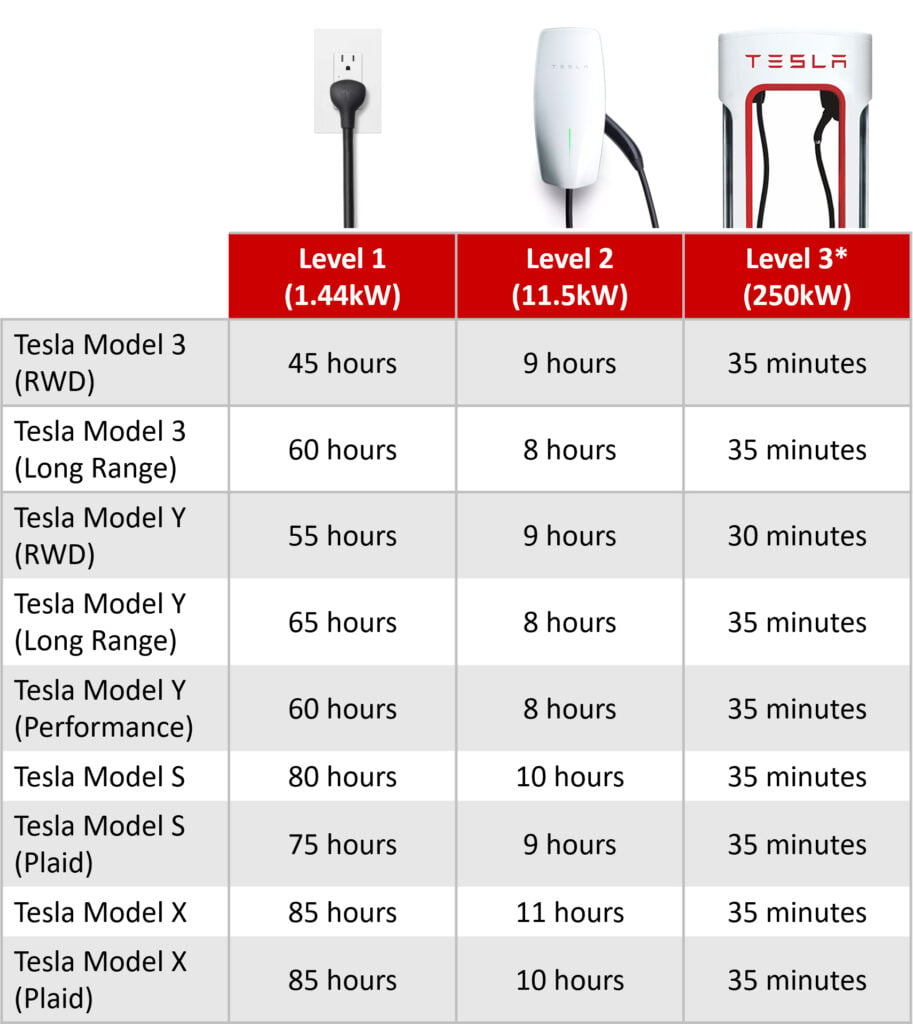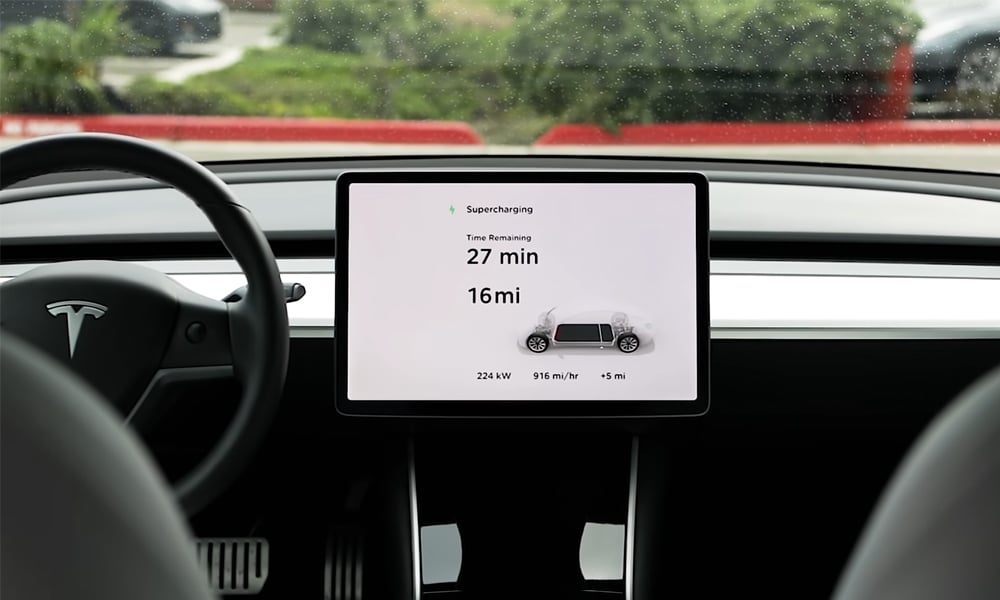Switching from a gas-powered car to a Tesla comes with a lot of benefits, except when you have to wait for it to charge. Depending on which Tesla you have and what kind of charger it’s plugged into, it could take anywhere from 15 minutes to several days to fill up your batteries. Here’s everything you need to know about how long it takes to charge the latest Tesla models at home and on the road, so you’ll be prepared for any drive.
Level 1 vs Level 2 vs Level 3
Level 1 EV chargers are just regular wall outlets, and they can take several days to fill up your Tesla. Level 2 chargers are found in homes, offices, and “destination chargers,” and they can fully charge your Tesla in under 10 hours. Superchargers can fill up a Tesla to 80% in about 30 minutes or less.
Read More: EV charging guide


If you’re thinking about installing an EV charger in your home, HelloTech can send someone to provide free in-home estimate. Our electricians will check your circuit breaker, assess the proposed installation location, and answer any EV charging questions you have – all for free.
How Long Does It Take To Charge a Tesla at a Supercharger?
Superchargers and other level 3 public charging stations provide the quickest way to fill up your Tesla. In ideal circumstances, you’ll be able to charge any new Tesla to 80% in under 30 minutes. With the latest V3 Superchargers, you can get up to 75 miles of range in just 5 minutes of charging.
The touchscreen in your Tesla will give you a good estimate of how long it will take to charge your car, but you can also calculate it yourself by taking your battery capacity and dividing it by the charging speed. For example, if you have a 75kWh (kilowatt-hour) battery, and you are charging at a speed of 250kW (kilowatts), it will take 0.3 hours (around 20 minutes) to fill it up.
Tesla doesn’t publish how big its batteries are, but filings with the EPA have shown the latest Model Y and Model 3 both have close to 80kWh, except the “short-range” models with RWD (rear-wheel drive), which only have around 60kWh. The Model S and Model X both have larger batteries close to 100kWh.
DC Charging Curves
When filling up your Tesla at a public charging station, you’ll notice it takes longer the more your battery fills up. When your battery is under 20%, it can achieve maximum charging speeds for a while, but you’ll only get a fraction of that speed after your batteries are over 80% full.
On the other hand, charging times will remain relatively stable when using a level 1 or level 2 charger until your battery reaches around 90%.
When you plug your Tesla into a DC fast charger, it takes a minute to communicate the proper charging speeds. Then you might be able to achieve maximum speeds when the battery’s state of charge (SoC) is between 10-30%, after which your Tesla will charge much slower.
Here are the average charging speeds for Teslas when the battery is between 10-80%, according to tests conducted by EVKX.
- Tesla Model 3 (RWD): 78.1kW
- Tesla Model 3 (LR): 97.0kW
- Model Y (LR): 101.2kW
- Model Y (Performance): 101.2kW
- Tesla Model Y (RWD): 84.1kW
- Tesla Model S: 131.8 kW
- Tesla Model S (Plaid): 131.8 kW
- Tesla Model X: 131.8 kW
- Tesla Model X (Plaid): 131.8 kW
It’s also important to note that all new Teslas automatically stop charging at 80% by default. This is done to make your batteries last longer and reduce wait times at Superchargers. While it is possible to charge your Tesla to 100% for longer road trips, Tesla advises against it for daily driving.
V2 vs V3 Tesla Superchargers
Not all public EV chargers are the same. When using a V3 Supercharger, you’ll get charging speeds up to 250kW, but older V2 chargers only carry 150kW. Supercharger stations also share power, so it can take longer if other EVs are plugged into the same charging station.
Almost all new Tesla models receive a maximum 250kW of power from a charging station, except the Model 3 RWD (rear wheel drive) and the Model Y RWD. These “short range” models can only reach a charging power of 170kW max.
How Long Does It Take To Charge a Tesla at Home?
With a level 2 wall connector, you’ll be able to fully charge any new Tesla in under 10 hours. After just one hour of charging, you’ll get up to 30-44 miles of range. However, charging times can vary based on your charger’s power output, your on-board charger power rating, and more.
The reason Level 2 chargers are so much slower than Superchargers is because they use alternating current (AC) instead of direct current (DC). Teslas and all other EVs have on-board chargers built in, which are used to convert AC power from a level 1 or level 2 charger into DC power.
Thankfully, Tesla has some of the best on-board charger ratings on the EV market. Many other EVs can only charge at a maximum of 7.7kW, but almost all new Teslas have an 11.5 kW on-board charger, except the Model 3 RWD and the Model Y RWD, which both have a 7.7 kW on-board charger.
If you want to find out how long it will take to charge your EV with a level 2 charger, all you need to do is take the battery capacity, divide it by the on-board charger’s power rating, and add 15% for battery loss. That means you’ll be able to fully charge almost any Tesla in around 10 hours or less, at least in ideal conditions.
For example, if your Tesla has a battery capacity of 80kWh and the on-board charger has a rating of 11.5kW, it can charge in about 8 hours.
Tesla’s own level 2 wall connectors can carry up to 240V at 48A. That will give you 11.5kW of power to charge your Tesla as fast as possible, but you’ll need to hook it up to a 60-amp circuit breaker.
Read More: How to choose the right EV charger
It’s also important to note that some Teslas are more efficient than others. For example, the Model X gets the lowest range per hour of charging, so it can take a little longer to charge.
How Long Does It Take To Charge a Tesla With a Mobile Connector?
The slowest way to charge your car is with a level 1 “mobile connector.” Basically, this just means plugging your car into a standard wall outlet. This can provide your Tesla with anywhere from 4-6 miles of range per hour of charging. Overall, it can take up to three and a half days to charge your Tesla with a mobile connector.
Read More: Level 1 vs level 2 EV chargers
When you purchase a new Tesla, you have the option to add a mobile connector bundle. This includes a NEMA 5-15 adapter to plug your Tesla into a regular household outlet and a NEMA 14-50 adapter, which lets you plug into a 240V outlet for level 2 charging.
If you need to use a different type of plug to charge your Tesla, the company also offers a NEMA adapter kit with seven additional adapters. Each type of connector has different power ratings, but you can calculate the power output for any plug by multiplying the volts and amps.
Read More: How much does it cost to charge an EV?
However, it’s important to note that your Tesla will only charge at 80% of the maximum amperage that your outlet is rated for. So, a NEMA 5-15 plug can carry 120V at 15 amps, but your Tesla will only charge at 12 amps (1.44kW).
You can also calculate your charging time by taking your Tesla’s total driving range and dividing it by the miles per hour of charging in the chart above. As you can see, the Model X charges slightly slower than other models.
If you need any help installing an EV charger in your home, HelloTech can send an electrician to your door to give you a free quote. We can provide an in-home quote in as little as 15-30 minutes, and our technicians can schedule your installation within a week or two of the estimate.


